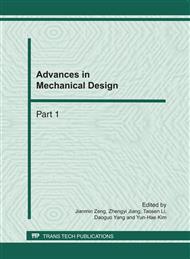p.1257
p.1262
p.1269
p.1273
p.1281
p.1287
p.1292
p.1297
p.1303
Optimal Control Discipline Research of Hydraulic System of Sugarcane Harvester
Abstract:
The actiyator of chassis mechanism of sugarcane harvester was a cubage flow regulation circuit consisted of a timing variable pump and a compensated flow control valve. The optimal controlling system described its movement from processing time using differential and state equations. The shortest-time optimal controlling trajectory of spring force of the variable pump was a group of concentric circles based on minimum principle, which controlling signal switched on origin trajectory. Under the condition of optimal control, the stator was pushed by spring to a new balance spot which left off origin 15.5 millimeter in the shortest time of 1.12 seconds, which provided theory base to further controlling system design. Its stability and validity has been proved well in physical product research.
Info:
Periodical:
Pages:
1281-1286
Citation:
Online since:
February 2011
Authors:
Price:
Сopyright:
© 2011 Trans Tech Publications Ltd. All Rights Reserved
Share:
Citation:


